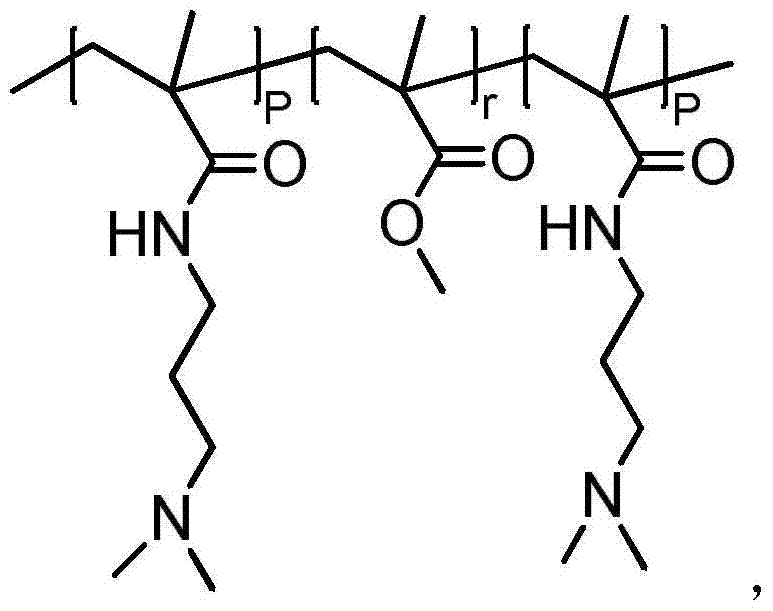Acrylic ester block copolymer and its synthesis method and application
An acrylate-based and synthetic method technology, which is applied in the field of ceramic ink dispersant, can solve the problems that the use performance cannot fully meet the use requirements, the polymer dispersant is late, the synthesis method is immature, etc., and achieves good coverage and encapsulation effects. The effect of increasing dispersion stability and excellent structure
- Summary
- Abstract
- Description
- Claims
- Application Information
AI Technical Summary
Problems solved by technology
Method used
Image
Examples
Embodiment 1
[0062] A kind of acrylic ester front polymer, its structure is as follows:
[0063] Wherein, n is 20, m is 30;
[0064] The synthetic method of described acrylic acid ester front end polymer, comprises the steps:
[0065] (1) 10.12g methyl methacrylate (MMA) (0.10mol), 0.282g RAFT reagent S, S'-di(2-methylpropionic acid) trithiocarbonate (0.001mol), 0.016g trigger Reagent azobisisobutyronitrile (AIBN) (1×10 -4 mol) and 57g of toluene were added to the reactor, stirred and mixed; under the condition of ice bath, the reactor was ventilated with nitrogen for 40min to remove the air, and then the temperature was raised to 70°C under the oil bath for reaction, and after 15h of reaction, the temperature was rapidly lowered and exposed to air In the process, the reaction is stopped, and the product obtained from the reaction is purified to obtain the intermediate product MMA macro-RAFT;
[0066] (2) 6.03g intermediate product MMA macro-RAFT, 8.51g monomer N-(3-dimethylaminopropy...
Embodiment 2
[0068] A kind of acrylic ester front polymer, its structure is as follows:
[0069] Among them, n is 21, m is 29;
[0070] The synthetic method of described acrylic acid ester front end polymer, comprises the steps:
[0071] (1) 15.02g methyl methacrylate (MMA) (0.15mol), 0.282g S, S'-di(2-methylpropionic acid) trithiocarbonate (0.001mol), 0.033g initiator couple Azobisisobutyronitrile (AIBN) (2×10 -4 mol) and 85g of ethyl acetate were added to the reactor, stirred and mixed; under the condition of ice bath, the reactor was ventilated with nitrogen for 40min to remove the air, and then the temperature was raised to 80°C under the oil bath for reaction, and after 20h of reaction, the temperature was rapidly lowered and exposed In the air, the reaction is stopped, and the product obtained from the reaction is purified to obtain the intermediate product MMA macro-RAFT;
[0072] (2) 5.81g intermediate product MMA macro-RAFT, 8.51g monomer N-(3-dimethylaminopropyl) methacrylam...
Embodiment 3
[0074] A kind of acrylic ester front polymer, its structure is as follows:
[0075] Among them, n is 17, m is 27;
[0076] The synthetic method of described acrylic acid ester front end polymer, comprises the steps:
[0077] (1) 30.01g methyl methacrylate (MMA) (0.30mol), 0.282g S, S'-di(2-methylpropionic acid) trithiocarbonate (0.001mol), 0.049g initiator couple Azodiisobutyronitrile (3×10 -4 mol) and 170g DMF were added to the reactor, stirred and mixed; under the condition of ice bath, the reactor was ventilated with nitrogen for 40min to remove the air, and then the temperature was raised to 75°C under the oil bath for reaction, and after 24h, the temperature was rapidly lowered and exposed to the air In the process, the reaction is stopped, and the product obtained from the reaction is purified to obtain the intermediate product MMA macro-RAFT;
[0078] (2) 5.45g intermediate product MMA macro-RAFT, 8.51g monomer N-(3-dimethylaminopropyl) methacrylamide (DMAPMA) (0.0...
PUM
 Login to View More
Login to View More Abstract
Description
Claims
Application Information
 Login to View More
Login to View More - Generate Ideas
- Intellectual Property
- Life Sciences
- Materials
- Tech Scout
- Unparalleled Data Quality
- Higher Quality Content
- 60% Fewer Hallucinations
Browse by: Latest US Patents, China's latest patents, Technical Efficacy Thesaurus, Application Domain, Technology Topic, Popular Technical Reports.
© 2025 PatSnap. All rights reserved.Legal|Privacy policy|Modern Slavery Act Transparency Statement|Sitemap|About US| Contact US: help@patsnap.com



